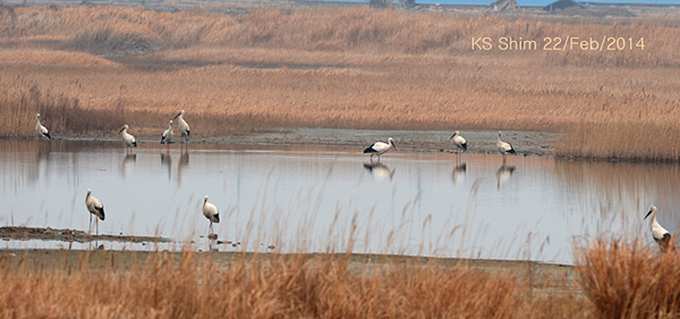Although there has been limited research effort by ornithologists, Baekryeong Island is important for waterbirds. The most important waterbird habitat on the island is a 40ha area of reed-bed, shallow open wetland and salt-pans at 37.93N, 124.69E close to Hwadong village and adjacent to a much larger reservoir. Waterbirds use this small wetland for feeding and as a secure, undisturbed roosting and nesting site. This area is now threatened by road and other construction.
During survey in March, May and November 2013 and again in February, March and April 2014, the 40ha wetland near Hwadong supported a total of eight globally Threatened and Near-threatened species. These included single globally Endangered Black-faced Spoonbill (저어새) Platelea minor in May 2013 and April 2014 and a flock of globally Endangered Oriental Stork (황새) Ciconia boyciana between November 2013 and March 2014. Between three and six Oriental Stork were present in early November; 17 were reported there by local media in January; and at least 14 were present in late February. This appears to be the largest concentration of wild Oriental Stork in the Republic of Korea in the winter of 2013/ 2014, and it is also the largest concentration nationwide known to Birds Korea since the mid-2000s. In addition, in November 2013, this small wetland also held 1,200 Taiga Bean Goose (큰부리큰기러기) Anser fabalis and nationally rare species including Mute Swan (혹고니) Cygnus olor and Greylag Goose (회색기러기) Anser anser.
The wetland also supports a high diversity of breeding species. Species suspected of breeding in 2013 include Little Grebe (논병아리) Tachybaptus ruficollis, Yellow Bittern (덤불해오라기) Ixobrychus sinensis and Von Schrenck’s Bittern (큰덤불해오라기) Ixobrychus eurhythmus, Far Eastern Oystercatcher (검은머리물떼새) Haematopus (ostralegus) osculans and Kentish Plover (흰물떼새) Charadrius alexandrinus.
The wetland has a high diversity of bird species throughout the year. It also supports Vulnerable and Endangered waterbird species. For this latter reason it is potentially internationally important for waterbirds as defined by the Ramsar Convention criteria. With appropriate management its value could be further improved, both to birds and people. Part of the wetland is already used for salt-making, and the area could provide an exceptional guided experience for eco-tourists and for school students, further boosting Baekryeong’s already-strong tourist industry.
However, much of the present value of this wetland to bird-life is now threatened by construction. Following on from drain construction in 2013, construction of a new road along the northern edge of the wetland was started in March 2014. At present (April 26) the road ends in the wetland, at 37.941 N, 124, 693 E. This is at the north-eastern edge of a 500m length of dyke that divides the wetland from the main reservoir. If construction of the road continues along the dyke to join with the main road at the northwestern corner (potentially reducing journey time for some cars by almost 1km), then disturbance to the wetland will be increased greatly.
Based on an understanding of waterbird usage of the site, if the road is extended, it is predicted that the site will no longer be able to support Oriental Stork or large concentrations of wintering waterbirds.
We would therefore like to appeal to Incheon City and local decision-makers to consider conservation of this site and the cancellation of the road.





Appendix
Globally Threatened and Near-threatened Bird Species recorded at the Hwadong Wetland in 2013 and 2014
- Swan Goose 개리 Anser cygnoides Vulnerable
- Falcated Duck 청머리오리 Anas falcata Near-threatened
- Japanese Quail 메추라기 Coturnix japonica Near-threatened
- Oriental Stork 황새 Ciconia boyciana Endangered
- Black-faced Spoonbill 저어새 Platelea minor Endangered
- Steller’s Sea Eagle 참수리 Haliaeetus pelagicus Vulnerable
- Yellow-breasted Bunting 검은머리촉새 Emberiza aureola Endangered
- Ochre-rumped Bunting 쇠검은머리쑥새 Emberiza yessoensis Near-threatened



